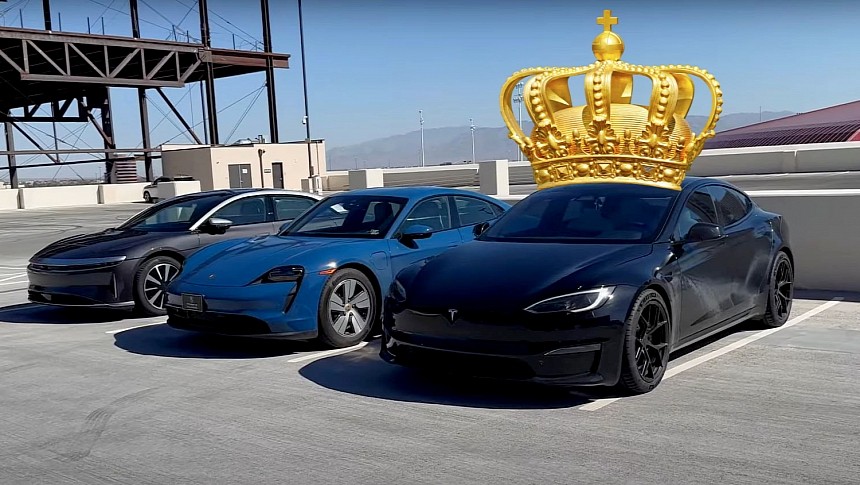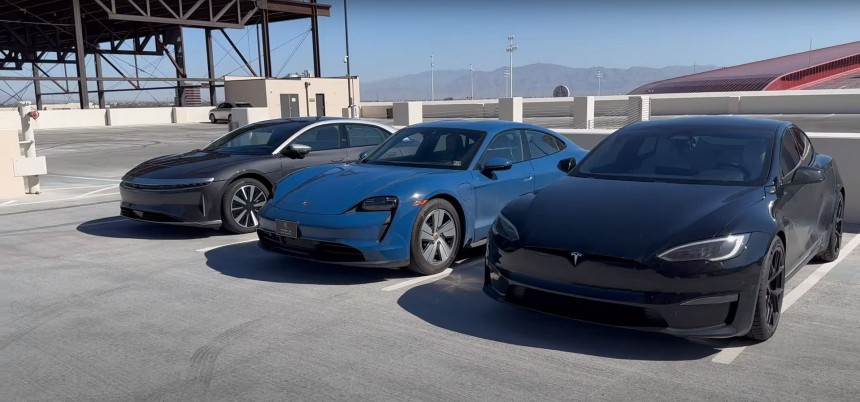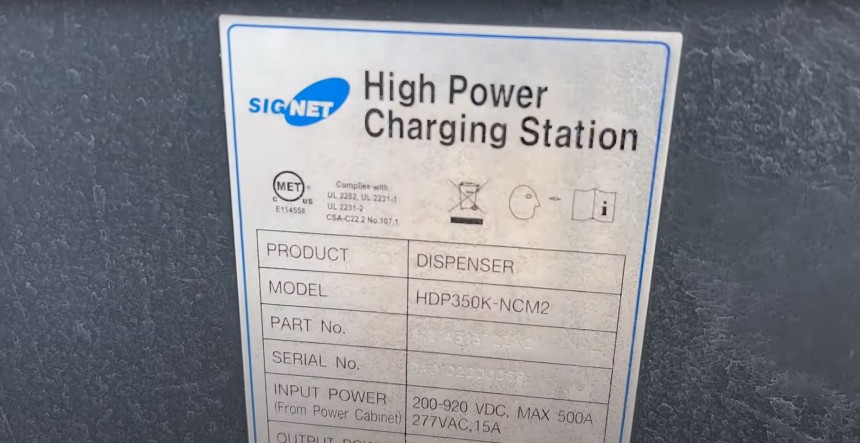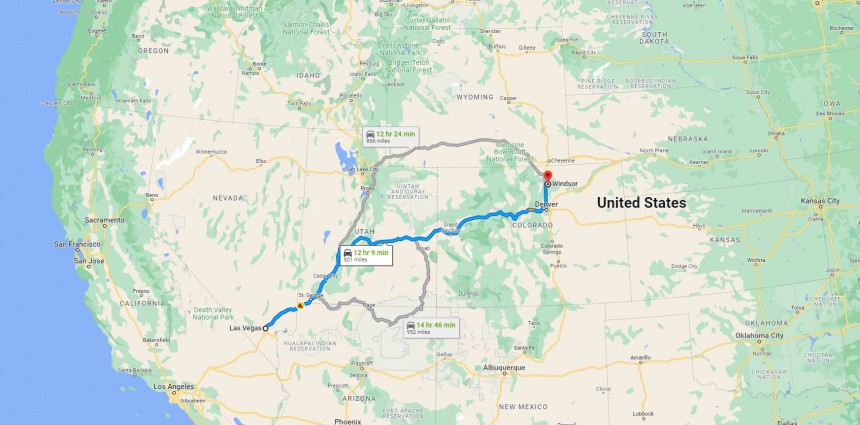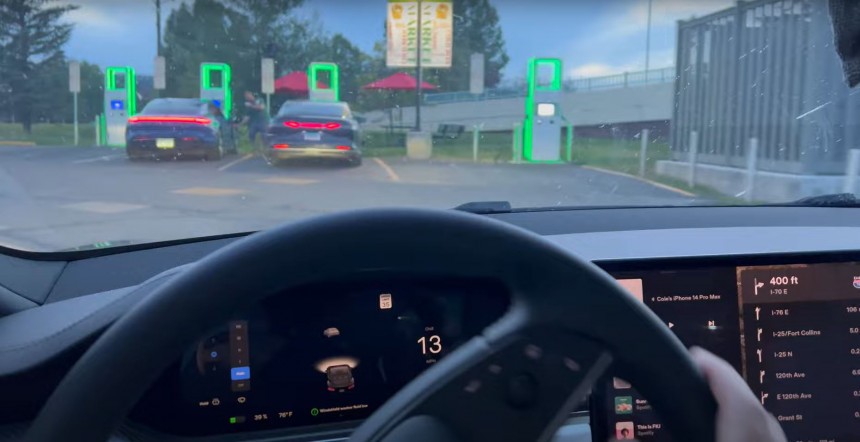Time is of the essence. But when road-tripping, being fast doesn't matter much. After all, longer journeys are for kicking it back and exploring. However, time management is important. That's especially true when it comes to EVs. Nobody wants to stay plugged in for hours every 200 miles. Fortunately, the Tesla Model S won't force you to waste precious vacation time.
A Porsche Taycan RWD, a Lucid Air Grand Touring, and a Tesla Model S Plaid were the electric vehicles (EVs) of choice for a road-tripping adventure from Windsor, Colorado, to Las Vegas, Nevada.
The EVs are personal cars, not press units. That matters because it gives us an authentic look at how these units perform when they're not overly used by members of the press or cautiously prepped beforehand by the automakers. Moreover, all three have been used in a similar fashion by their owners and show around 12,500 miles on the odometer.
The Air has a 112-kWh battery pack, the Taycan boasts an 84-kWh energy storage unit (the Performance Battery Plus), while the Model S uses a 95-kWh electric current source. These are all usable figures and enable the sedans to go hundreds of miles on a single charge.
However, according to the Environmental Protection Agency (EPA), the Lucid has the most range – 516 miles. The Tesla can go 348 miles on a full charge, while the Taycan RWD with the larger battery pack runs just 225 miles, according to the same source. Keep in mind that these figures may vary wildly depending on weather, driving style, and the energy storage unit's degradation level.
Still, one could be inclined to declare the Lucid Air Grand Touring as the winner and call it a day.
The Taycan, the Air, and the Model S featured in this race have previously been taken for other longer journeys, so the team involved in this test knew they had to avoid some Electrify America stalls (the SK Signet-made ones) because they do not perform well with some vehicles that have the 800V architecture.
Lucid and Hyundai/Kia cars have often reported rapidly oscillating charging speeds that worry owners about possible battery degradation or other electrical equipment problems. But the Taycan used in this experiment went through the same thing. It's worth noting that a direct effect of the "Signet Surge" isn't yet known. It may or may not lead to more battery wear or affect other vital components.
The first EV race between the three vehicles from Colorado to Nevada put the Tesla in the top spot. It was the first to arrive in Las Vegas. The Lucid Air needed a little over half an hour more to join the Model S Plaid, while the Porsche got to the meeting place last (with a one hour and 10 minutes delay) because it had to wait in queue for electrons and was stuck in traffic.
Before they started, the drivers also agreed not to go more than five mph over the posted speed limit.
The journey back to Colorado began on a sunny day when the outside temperature was around 110 degrees Fahrenheit (43 degrees Celsius), with the all-electric sedans charged to full. Remember that extreme temperatures may impact the maximum range of an EV because the battery management system needs to work overtime to keep the pack's temperature at an optimum level.
The initial range estimation at the departure point in Las Vegas was 235 mi for the Model S, 247 mi for the Taycan, and 515 mi for the Air.
The Tesla Model S Plaid and the Porsche Taycan RWD needed to charge after 222 miles of driving. The EVs were both at 8% state of charge (SoC). Meanwhile, the Lucid Air Grand Touring had 33% battery left. Thus, the vehicle with the larger energy storage unit could move in the first place by simply remaining on the road.
While the Lucid Air remained plugged in, the Porsche and the Tesla flew past it. The leaderboard kept changing throughout the race to Colorado, but the team met at the Grand Junction Electrify America charging and Supercharger stations – 505 miles away from their starting point.
But sticking together didn't take long. The Model S Plaid charged a bit and left, effectively becoming the first to travel toward Windsor, Colorado. However, it had to stop for one more session, while the Taycan and Air didn't need another pause.
Still, that extra three-minute stop to recharge didn't matter. The Tesla arrived first at the end-of-race meeting point after 12 hours and 40 minutes of driving. The Porsche and the Lucid joined the Model S a couple of minutes later. Technically, the Air lost by only a second.
However, the Air and the Taycan arrived with around 14% SoC, while the Tesla was nearing depletion with just 2% left.
From Windsor, Colorado, to Las Vegas, Nevada, the Tesla had the upper hand simply because of the Supercharger network. Returning to the race's starting point with enough knowledge about which stalls to use helped the CCS Combo 1-equipped EVs shave off some of the initial time difference, but they still lost to the Tesla driver, who had more confidence in the Model S Plaid.
Ultimately, it all came down to DC fast-charger reliability (and correct labeling), charging stall knowledge, and driver risk appetite.
Sadly, that proves that the Air Grand Touring's larger battery is not much help when the charging network isn't completely reliable. Ford was right in making the first move towards adopting the NACS connector.
The EVs are personal cars, not press units. That matters because it gives us an authentic look at how these units perform when they're not overly used by members of the press or cautiously prepped beforehand by the automakers. Moreover, all three have been used in a similar fashion by their owners and show around 12,500 miles on the odometer.
The Air has a 112-kWh battery pack, the Taycan boasts an 84-kWh energy storage unit (the Performance Battery Plus), while the Model S uses a 95-kWh electric current source. These are all usable figures and enable the sedans to go hundreds of miles on a single charge.
However, according to the Environmental Protection Agency (EPA), the Lucid has the most range – 516 miles. The Tesla can go 348 miles on a full charge, while the Taycan RWD with the larger battery pack runs just 225 miles, according to the same source. Keep in mind that these figures may vary wildly depending on weather, driving style, and the energy storage unit's degradation level.
Not so fast, watt wasters!
But long-distance EV traveling depends on more than just a large battery pack and efficient motors. At the same time, the rear-wheel-drive Porsche could also be a strong contender for first place because it has just one motor and an impressive charging curve. So, how can the 1,020-hp Plaid with three motors and a presumably hefty energy consumption take the win? Let's see.The Taycan, the Air, and the Model S featured in this race have previously been taken for other longer journeys, so the team involved in this test knew they had to avoid some Electrify America stalls (the SK Signet-made ones) because they do not perform well with some vehicles that have the 800V architecture.
Lucid and Hyundai/Kia cars have often reported rapidly oscillating charging speeds that worry owners about possible battery degradation or other electrical equipment problems. But the Taycan used in this experiment went through the same thing. It's worth noting that a direct effect of the "Signet Surge" isn't yet known. It may or may not lead to more battery wear or affect other vital components.
Now playing John Denver's "Back Home Again"
Each Out of Spec Motoring crew member made their own fast-charging plans for the return home race. But the advantage was that they knew what they would have to deal with charging-wise. The Lucid Air didn't require as many stops as the Porsche Taycan RWD, but it did depend on Electrify America's ABB-made stalls to work correctly. The Model S Plaid had the Supercharger network with V3 stalls on the route, but the driver knew it wasn't as efficient as the other two. The Taycan should've theoretically been the most efficient, given its smaller energy storage unit and just one motor.Before they started, the drivers also agreed not to go more than five mph over the posted speed limit.
The journey back to Colorado began on a sunny day when the outside temperature was around 110 degrees Fahrenheit (43 degrees Celsius), with the all-electric sedans charged to full. Remember that extreme temperatures may impact the maximum range of an EV because the battery management system needs to work overtime to keep the pack's temperature at an optimum level.
The initial range estimation at the departure point in Las Vegas was 235 mi for the Model S, 247 mi for the Taycan, and 515 mi for the Air.
One step forward, two steps back
The Air stopped to charge after reaching 17% SoC. But out of the four Electrify America stalls, only two worked. The driver chose one and quickly found out it dispensed energy at a rate of 72 kW, even though the stall was capable of a lot more. He had to move to the other working booth, but the Plug&Play function failed. The driver had to manually confirm payment, which meant more lost time. But it worked, and the vehicle received electrons from the grid at 175 kW an hour.While the Lucid Air remained plugged in, the Porsche and the Tesla flew past it. The leaderboard kept changing throughout the race to Colorado, but the team met at the Grand Junction Electrify America charging and Supercharger stations – 505 miles away from their starting point.
But sticking together didn't take long. The Model S Plaid charged a bit and left, effectively becoming the first to travel toward Windsor, Colorado. However, it had to stop for one more session, while the Taycan and Air didn't need another pause.
However, the Air and the Taycan arrived with around 14% SoC, while the Tesla was nearing depletion with just 2% left.
A stark reality and a wake-up call
The Lucid Air Grand Touring returned an energy consumption of 3.5 miles per kWh, the Porsche Taycan RWD 3.1 miles per kWh, while the Tesla Model S Plaid didn't share this statistic. But the average should be around 2.9 miles per kWh.From Windsor, Colorado, to Las Vegas, Nevada, the Tesla had the upper hand simply because of the Supercharger network. Returning to the race's starting point with enough knowledge about which stalls to use helped the CCS Combo 1-equipped EVs shave off some of the initial time difference, but they still lost to the Tesla driver, who had more confidence in the Model S Plaid.
Ultimately, it all came down to DC fast-charger reliability (and correct labeling), charging stall knowledge, and driver risk appetite.
Sadly, that proves that the Air Grand Touring's larger battery is not much help when the charging network isn't completely reliable. Ford was right in making the first move towards adopting the NACS connector.
